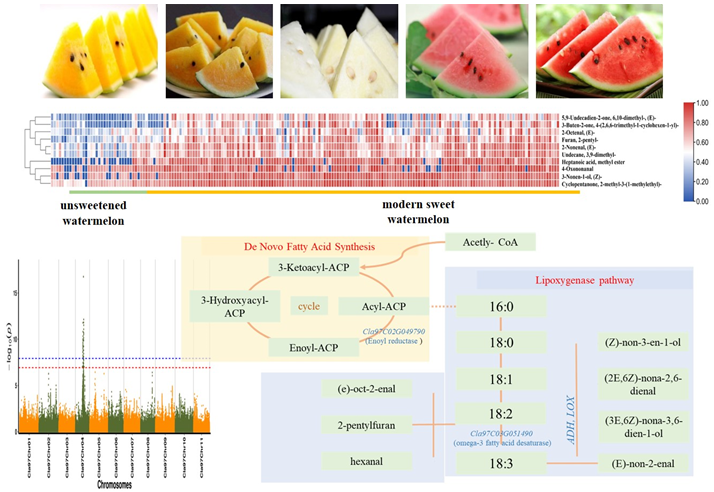Recently, the Watermelon Genetic Breeding and Cultivation innovation team of Zhengzhou Fruit Research Institute published a paper entitled " Multi-omics integration to explore the molecular insight into the volatile organic compounds in watermelon " in Food Research International.In this paper, the accumulation pattern of volatile organic compounds and the molecular basis of genetic variation in watermelon fruit were systematically studied, which laid the foundation for the improvement of watermelon flavor quality.
Fruit quality has always been a hot topic in horticultural crop research. This team constructed the first watermelon fruit metabolome database and analyzed the domestication sequence and regulation mechanism of taste and flavor during watermelon evolution. On the basis of previous studies, SPEM-GC-MS technology was used to determine the volatile organic compounds in watermelon fruit development and natural population in this study,it was found that geranylacetone and β-ionone were the key metabolites related to watermelon flesh color and sugar content. Lycopene β-cyclase gene LCYB and carotenoid cracking dioxygenase gene CCD, which were closely related to watermelon flesh color, were excavated from watermelon chromosome 4. Further study revealed that Cla97C05G092490 of E3 ubiquitin ligase family gene might regulate the accumulation of β-ionone by interacting with PSY, the octa lycopene synthetase gene. The enol reductase gene Cla97C02G049790, the omega-3 fatty acid dessaturatase gene Cla97C03G051490, LOX and ADH affect the synthesis of aroma related lipid metabolites by regulating lipoxygenase pathway.
This research was supported by Agricultural Science and Technology Innovation Program, the China Agriculture Research System of MOF and MARAand other projects.
Download link: https://www.sciencedirect.com/science/article/abs/pii/S0963996923001485

Accumulation of volatile organic metabolites in watermelon fruit and mining of key regulatory genes
By Zhu Hongju
zhuhongju@caas.cn
